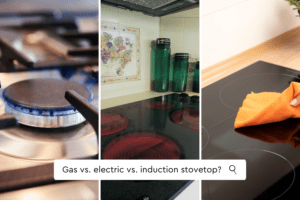
“The government is coming for your gas stove! Not over my dead body” is the common refrain we’re hearing this week even from many of our solar clients that power everything – home, car, heating – with electricity, except their gas stove.
It started in December when Richard Trumpka Jr., a member of the Consumer Product Safety Commission, addressed the growing scientific findings that gas stoves pose a threat to human health. When asked whether gas stoves could be banned, Trumpka said “any option is possible.” Per the New York State Scoping Plan, Governor Hochul has proposed a ban on gas connections for new small buildings in 2025 and large buildings in 2028, but this would not require replacing existing gas stoves. NYC has already passed a bill requiring all new buildings to be all-electric, starting at the end of this year for low-rise buildings and in 2027 for high-rises.
Here’s EmPower’s perspective:
EmPower Solar’s role is to help educate and empower customers to save money and electrify their lives with solar.
Using solar to power your home, car, and heating system is an amazing, state of the art experience. Electric induction stoves are fun and wonderful to cook with. EmPower COO Greg Sachs lived in an off-grid solar home with an induction stove that we installed the energy systems on in 2005 for the solar decathlon house located at the US Merchant Marine Academy.
Regarding how to inspire people to switch to solar and electric house loads, using laws and building codes are important avenues to consider that can dramatically improve the quality of the air we breathe inside and outside the home.
Are gas stoves unsafe?
The short answer is yes. Gas stoves release alarming amounts of air pollutants like nitrogen dioxide (NO2), particulate matter (PM2.5), carbon monoxide (CO), formaldehyde (CH2O), and methane (CH4) when they’re ignited and even when they’re turned off.
Methane is an incredibly potent and flammable greenhouse gas, causing about 30% of global warming since the pre-Industrial Revolution era. While methane doesn’t stick around in the atmosphere as long as CO2, it works quicker and more powerfully; in its first 20 years methane is over 80 times more effective at trapping heat than carbon dioxide. Over this 20-year timeframe, researchers found that annual methane emissions from gas stoves in the U.S. alone have a climate impact comparable to CO2 emissions from half a million cars. Notably, over 75% of methane emissions occur when your gas stove is off.
Not only do gas stoves release greenhouse gasses that accelerate global warming, they also emit air pollutants that trigger serious respiratory illness. The EPA determined that long-term exposure to nitrogen dioxide (NO2) is linked to respiratory illnesses such as asthma, especially among children. A recent study shows that pollution from gas stoves contribute to 12.7% of childhood asthma in the U.S., and scientists found that the pollutants from gas stoves have the same risk for children as secondhand smoke exposure. In homes without proper ventilation, the indoor level of NO2 could surpass the EPA’s outdoor standard within minutes.
Besides the indoor air pollutants released and potential gas leaks, the open flame produced by gas stoves poses a safety risk for young children and adults alike.
Gas stove alternatives
Electric stoves
Many people are familiar with the traditional resistance electric stove, often with metal coil burners. However, electric stove technology has come a long way in recent years, and the three main types are coil-top, glass-top (also called radiant), and induction. We’ll cover induction in more detail in the next section.
Coil-top and radiant stoves are similar in that they both operate on independent circuits, with electricity running through the circuit to generate heat in the coil. The primary difference is that the coil is exposed in coil-top stoves, while the coil is hidden under the glass or ceramic surface of radiant stoves.
Induction stoves
Swiftly gaining popularity are induction stoves, which are more efficient and precise than conventional electric stovetops. Induction stoves are technically a type of electric stove, but they operate differently. Induction stovetops use electricity to generate an electromagnetic field below the glass or ceramic cooktop surface, which transfers a current directly to the cookware, causing it to heat up.
Induction stoves are already a prominent fixture in European and Asian households, and eminent chefs like Eric Ripert and Justin Lee actually prefer induction over gas because of its precision.
Benefits of induction stoves:
- Safety – besides not releasing any indoor air pollutants, induction stovetops don’t have open flames or hot coils, nor does the cooktop surface heat up. The only item that gets hot is the cookware itself.
- Speed + efficiency – unlike gas or conventional electric stoves, there’s zero energy loss when using an induction stove. Induction transfers energy directly to the pan and the food, causing food to eat quicker. With induction cooking, water boils in just minutes.
- Cooler kitchen – with no open flame or hot coils, induction stoves don’t heat up your kitchen the same way that gas or conventional electric stovetops do, making cooking in the summer a breeze.
- Easy cleanup – if food drips on to an induction stovetop there’s no bubbling or burning, since the cooktop isn’t hot. You can clean messes right away, and the flat surface makes cleaning as easy as a wipe.
However, there are two things to keep in mind when considering an induction stove: (1) induction stoves require magnetic cookware and (2) the magnetic field may interfere with pacemakers and insulin pumps.
Making the switch to an electric or induction stove
Electric and induction stovetops are safer and healthier for your family, without the air pollutant by-products, risk of a gas leak, or open flame. Electric and induction stoves are also more energy efficient than gas stoves, and with the incentives supported by federal and local government, now is the time to make the switch.
Incentives and rebates
Through the Inflation Reduction Act (IRA), the federal government set aside $4.5 billion for states to fund rebates for the purchase of new electric appliances, including ranges, cooktops, and wall ovens. Depending on your income, you can save up to $840 on a new stove and an additional $500 if you’re switching from natural gas or propane to electric.
If increasing the number of electric appliances in your home requires you to upgrade your electrical panel, you could also be eligible for a tax credit of up to $4,000 to cover that expense.
Maximize your savings with clean energy
Electrifying your kitchen is an important step in electrifying your life, and renewable energy sources like solar can power your electric appliances at an even lower price.
If you already have a solar system, it’s worth seeing if your solar panels produce enough electricity to power an electric kitchen. If not, we can assess any remaining roof or ground surfaces you have and make a recommendation on adding panels to cover your new energy load.
If you’re currently looking into solar for your home, we can size your system to accommodate clean energy equipment such as an electric or induction stove.
One hesitation that people have regarding electric stoves is that you can’t cook if there’s a power outage. If maintaining the ability to cook during an outage is important to you, adding a battery backup system like the Tesla Powerwall will help keep your home and its appliances running during a power outage, which is especially important as extreme weather events become the new normal.
Ready to power your electrified home with clean energy while maximizing savings? Contact us today to get started.
Say goodbye to high-energy bills and hello to worry-free solar

Say goodbye to high-energy bills and hello to worry-free solar
About the Author
EmPower Solar develops, engineers, installs, and services solar and battery systems for residential and commercial clients. Since 2003, EmPower Solar has empowered thousands of New York homeowners and businesses with 47 megawatts of distributed solar. Its vision is to create a new energy paradigm powered by clean, renewable energy for a more prosperous, healthy, and civil world. The company culture is defined by the EmPowering Way, which results in consistent 5-star customer service reviews. For more information visit empower-solar.com.